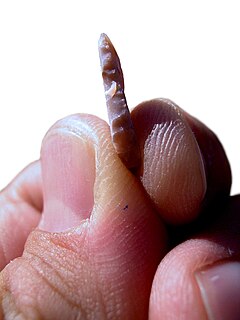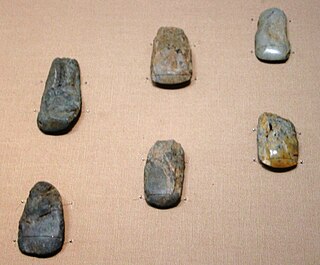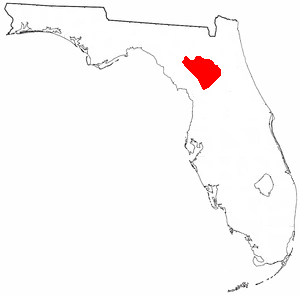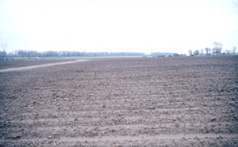
A microlith is a small stone tool usually made of flint or chert and typically a centimetre or so in length and half a centimetre wide. They were made by humans from around 35,000 to 3,000 years ago, across Europe, Africa, Asia and Australia. The microliths were used in spear points and arrowheads.
In archaeology, lithic analysis is the analysis of stone tools and other chipped stone artifacts using basic scientific techniques. At its most basic level, lithic analyses involve an analysis of the artifact’s morphology, the measurement of various physical attributes, and examining other visible features.

The Nordic Bronze Age is a period of Scandinavian prehistory from c. 1700–500 BC. The Bronze Age culture of this era succeeded the Nordic Stone Age culture and was followed by the Pre-Roman Iron Age. The archaeological legacy of the Nordic Bronze Age culture is rich, but the ethnic and linguistic affinities of it are unknown, in the absence of written sources. Some scholars also include sites in what is now Finland, Estonia, northern Germany and Pomerania, as part of its cultural sphere.

The Japanese Paleolithic period is the period of human inhabitation in Japan predating the development of pottery, generally before 10,000 BC. The starting dates commonly given to this period are from around 40,000 BC; although any date of human presence before 35,000 BC is controversial, with artifacts supporting a pre-35,000 BC human presence on the archipelago being of questionable authenticity. The period extended to the beginning of the Mesolithic Jōmon period, or around 14,000 BC,
Dong Son is the name of a number of towns and villages in Vietnam.

The Alachua culture is a Late Woodland Southeast period archaeological culture in north-central Florida, dating from around 600 to 1700. It is found in an area roughly corresponding to present-day Alachua County, the northern half of Marion County and the western part of Putnam County. It was preceded by the Cades Pond culture, which inhabited approximately the same area.
The archaeological La Jolla Complex represents a prehistoric culture oriented toward coastal resources that prevailed during the middle Holocene period between c. 6000 BC and AD 500 in southwestern California and northwestern Baja California.

Spirit Cave is an archaeological site in Pang Mapha district, Mae Hong Son Province, northwestern Thailand. It was occupied 12,000 to 7,000 uncalibrated radiocarbon years ago by prehistoric humans of the Hoabinhian culture.

The European Bronze Age is characterized by bronze artifacts and the use of bronze implements. The regional Bronze Age succeeds the Neolithic. It starts with the Aegean Bronze Age in 3200 BC (succeeded by the Beaker culture), and spans the entire 2nd millennium BC in Northern Europe, lasting until c. 600 BC.
The Red Ocher people were an indigenous people of North America. A series of archaeological sites located in the Upper Great Lakes, the Greater Illinois River Valley, and the Ohio River Valley in the American Midwest have been discovered to be a Red Ocher burial complex, dating from 1000 BC to 400 BC, the Terminal Archaic – Early Woodland period. Characterized as shallow burials located in sandy ridges along river valleys, covered in red ochre or hydrated iron oxide (FeH3O), they contain diagnostic artifacts that include caches of flint points, turkey-tails, and various forms of worked copper. Turkey-tails are large flint blades of a distinct type. It is believed that Red Ocher people spoke an ancestral form of the Algonquian languages.

The Nodena Site is an archeological site east of Wilson, Arkansas and northeast of Reverie, Tennessee in Mississippi County, Arkansas, United States. Around 1400–1650 CE an aboriginal palisaded village existed in the Nodena area on a meander bend of the Mississippi River. The Nodena site was discovered and first documented by Dr. James K. Hampson, archaeologist and owner of the plantation on which the Nodena site is located. Artifacts from this site are on display in the Hampson Museum State Park in Wilson, Arkansas. The Nodena Site is the type site for the Nodena Phase, believed by many archaeologists to be the province of Pacaha visited by Spanish explorer Hernando de Soto in 1542.

Albany Mounds State Historic Site, also known as Albany Mounds Site, is a historic site operated by the Illinois Historic Preservation Agency. It spans over 205 acres of land near the Mississippi river at the northwest edge of the state of Illinois in the United States. In 1974, the site was added to the National Register of Historic Places list. The historical site is under the provision of the Illinois Historic Preservation Agency, a governmental agency founded in 1985 for the maintaining of historical sites within the state. In the 1990s, the site underwent a restoration project that aimed to return its appearance to its original condition.

The Eva site (40BN12) is a prehistoric Native American site in Benton County, Tennessee, in the Southeastern United States. Located along an ancient channel of the Tennessee River, the Eva site saw extensive periods of occupation during the Middle and Late Archaic period. The site's well-defined midden layers helped investigators identify three distinct Archaic cultures, the oldest of which was first identified at Eva and is still known as the "Eva culture" or the "Eva phase."

The Con Moong cave is located in the Cúc Phương National Park, just south of Mọ village, in the Thanh Hóa Province, northern Vietnam. The Cúc Phương National Park administration not only manages a refuge for rare animals. The Department of Culture has also issued a certificate, that declares Con Moong prehistoric site and its surroundings as National Relics. Among these locations, the archaeological site of Con Moong cave is of central importance for the study of the Mesolithic Hoabinhian culture. In April and May 1976 Vietnamese archaeologists have excavated the site.
The Phùng Nguyên culture of Vietnam is a name given to a culture of the Bronze Age in Vietnam which takes its name from an archeological site in Phùng Nguyên, 18 km (11 mi) east of Việt Trì discovered in 1958. It was during this period that rice cultivation was introduced into the Red River region from southern China. The most typical artifacts are pediform adzes of polished stone.
The Sơn Vi culture is the name given to a culture of the late Palaeolithic and early Mesolithic Age in Vietnam.

Tham Lod Rockshelter, first researched by Rasmi Shoocongdej from Silpakorn University, funded by the Thai Research Fund, was a prehistoric cemetery and a workshop located in Northern Thailand known to have human inhabitants from the late Pleistocene to the late Holocene period Additionally, Tham Lod is near Ban Rai, another rock shelter and is in the vicinity of two well known caves, Spirit Cave and Tham Lot cave. Recent researches and carbon dating suggested that Homo sapiens have occupied the area. These researches provide more detail on the activities by the humans in the area which includes burials, living habits, gathering, and tool making, and social interactions.

Laang SpeanCave of Bridges refers to a prehistoric cave site on top of a limestone hill in Battambang Province, north-western Cambodia. The site's name Cave of Bridges hints to the many limestone arches that remain after the partial collapse of the cave's vault. Although excavations are still in progress, at least three distinct levels of ancient human occupation are already documented. At the site's deepest layers, around 5 meters below the ground primitive flaked stone tools were unearthed, dating back to around 71,000 years BP. Of great interest are above layers that contain records of the Hoabinhian whose stratigraphic and chronological context has yet to be defined. Future excavations at Laang Spean might help to clarify the concept and "nature of the Hoabinhian" occupation and provide new data on the Pleistocene/Holocene transition in the region

Mán Bạc is a Neolithic archaeological site located in Yên Mô District, Ninh Bình Province, Vietnam, dated from around 1,850–1,650 BC. Mán Bạc is associated with the Phùng Nguyên culture. With 95 burials found at the site, Mán Bạc is the largest and most intact site associated with the Phùng Nguyên culture, surpassing the site at Lung Hoa.













